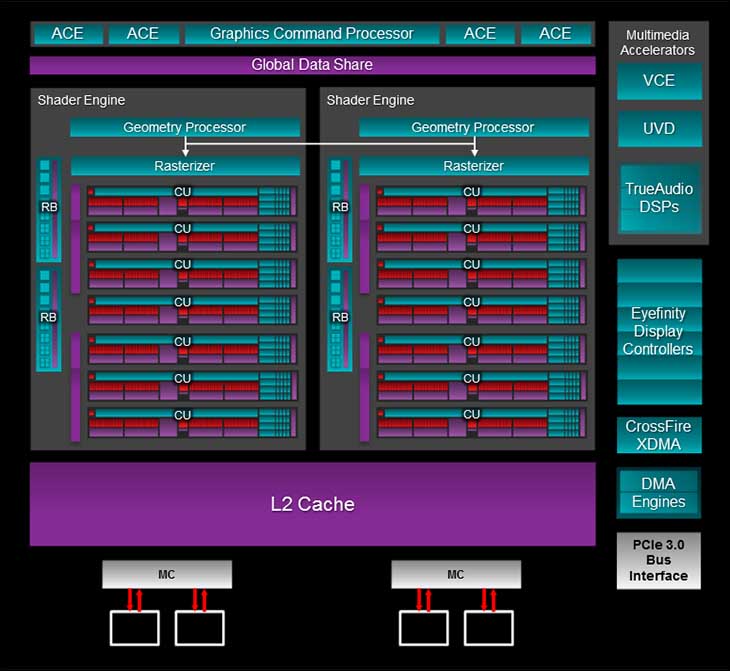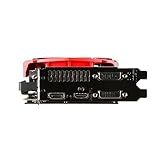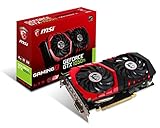Due to the release of the AMD Fury series, the 390X did not get as much attention as it should have. Worse still is a lot of the attention it did receive was negative attention. Even before it launched the Internet was filled with cries of ‘REBRAND’ and similar talk that was sure to turn off consumers…even before it could show consumers what it had to offer. This is a shame as at the end of the day its abilities to push pixels, and not what it uses to do it, that matters most.
So what exactly is the R9 390X and why should consumers care about what it represents? The answer to that is simple and yet complicated to explain. First and foremost this video card uses the new Grenada XT core. Contrary to what some people will tell you the Grenada XT is not just a rebranding of the Hawaii core that powered the R9 290X. Instead it is best described as a refresh to the Hawaii architecture – similar to what Intel does on their ‘Tock’ CPU releases. Much like Intel and their CPU division, AMD has taken their existing Hawaii core and improved it so that it not only has lower power consumption but is also faster than its predecessor. This double boost in conjunction with a much lower asking price compared to the GTX 980 series is why consumers should care about the R9 390X series – as it represents competition in the mid to high end of the marketplace. A corner of the market that is in sore need of competition!
On the surface, more performance but lower power demands would seem like a good thing that no one could complain about. Unfortunately, the Internet is obsessed with new, and while AMD have improved their lineup to be more competitive, what AMD has not done is change the core specifications or even core layout of their ’90X model. This is why the Internet is ringing with cries of rebrand and rebadge. At the heart of the Grenada XT / Hawaii cores is four Shader Engines. Each Shader Engine can be considered a ‘block’ made up of eleven sub blocks called a Compute Unit. Each Compute Unit is made up of a smaller building block consisting of 4 SMID sub-blocks….and that is far enough down the rabbit hole. Instead we will simply say that a SMID has 16 shaders. If you add all that up (16 x 4 x 11 x 4) you end up with a massive 2816 shader units. Which is the same number of shader units as a NVIDIA GeForce GTX 980Ti has.
At the heart of the Grenada XT / Hawaii cores is four Shader Engines. Each Shader Engine can be considered a ‘block’ made up of eleven sub blocks called a Compute Unit. Each Compute Unit is made up of a smaller building block consisting of 4 SMID sub-blocks….and that is far enough down the rabbit hole. Instead we will simply say that a SMID has 16 shaders. If you add all that up (16 x 4 x 11 x 4) you end up with a massive 2816 shader units. Which is the same number of shader units as a NVIDIA GeForce GTX 980Ti has.
Also like a 980TI, the Grenada XT core has 176 Texture Units, but unlike the 980TI only has 64ROPS – or the same as a GTX 980. Of course you cannot directly compare them to each other as it is an apples and oranges type of deal. Further making direct comparison difficult is the NVIDIA 980Ti core relies upon six integrated 64-bit memory controllers (384-bit wide bus), whereas Grenada XT has eight of them (512-bit bus).….but you do get an idea of the kind of horsepower this ‘rebrand’ has. Also like what NVIDIA can do, AMD can disable Compute Units or even Shader Engines to make smaller cores to power lower end models. For example cut off four Compute Units per Shader Engine (but leave it with four Shader Engines and eight memory controllers) and you have the 380’s Antigua Pro core.
Also like what NVIDIA can do, AMD can disable Compute Units or even Shader Engines to make smaller cores to power lower end models. For example cut off four Compute Units per Shader Engine (but leave it with four Shader Engines and eight memory controllers) and you have the 380’s Antigua Pro core. Conversely, cut off four of Compute Units per Shader Engine and then entirely remove two Shader Engines (as well as four of the eight integrated memory controllers) and you have the 370’s Trinidad core.
Conversely, cut off four of Compute Units per Shader Engine and then entirely remove two Shader Engines (as well as four of the eight integrated memory controllers) and you have the 370’s Trinidad core.
To be fair it is disappointing to see the number of shaders, ROPS, and texture units have not increased with this new generation ’90X; but the only area that consumers will dislike is the fact that a R9 290X can be found for about $350 but the R9 390X commands $425 asking price. That is a seeming steep increase for 25watt reduction in power, and small boost in clock speed. However, the $75 buys you twice the amount of RAM – as all R9 390X’s come with 8GB and not 4GB of ram. A more fair comparison is a R9 290X 8GB vs R9 390X, and here the difference in price is more like 30 dollars. That is not much of a ‘price gouge’ like some Internet pundits were decrying.
Now should existing R9 290X consumers be looking at R 390X cards? No, but that is not a fair comparison – few consumers upgrade that quick. Instead a more fair comparison is older card owners who should be thinking about the AMD R9 390x vs. NVIDIA GeForce GTX 980 equation. That is the question we will help you answer with this review.











